Plumbing And Bladder
Click on an image to see a larger version
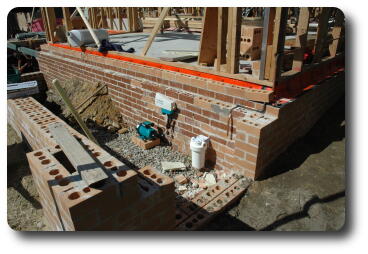 The western end of the porch area, showing the pump,
filter and the automatic switch over to town water if the bladder
is emptied. The rain water in the bladder is used to fill the
toilet cisterns, and outside taps. Thus, it is important that
there be a backup water supply should the bladder be emptied.
The western end of the porch area, showing the pump,
filter and the automatic switch over to town water if the bladder
is emptied. The rain water in the bladder is used to fill the
toilet cisterns, and outside taps. Thus, it is important that
there be a backup water supply should the bladder be emptied.
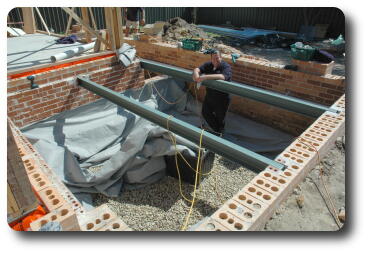 Robin, from Tanked Australia, working in the bladder area.
The material on the ground is a protective sheet to safeguard
the bladder from the rough edges of the hole.
Robin, from Tanked Australia, working in the bladder area.
The material on the ground is a protective sheet to safeguard
the bladder from the rough edges of the hole.
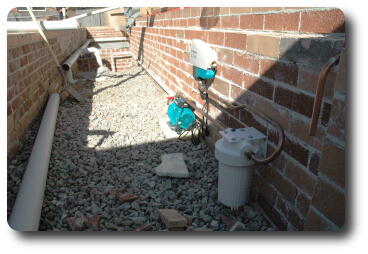 The completed plumbing arrangements - completed as far as the
bladder installation is concerned; the town water supply connection
to, and the water supply to the house need to be made. The
pipe on the far right is the outlet, which runs along the western
wall of the family room, over the door at the southern end and on
to the toilet cisterns. Visible in the distance is the first flush
diverter. The rain water enters via the large diameter pipe coming
in from the far end; there'll be another connection at this end too.
The water is sucked fro the bladder, through the pump, the filter
and into the switch over device.
The completed plumbing arrangements - completed as far as the
bladder installation is concerned; the town water supply connection
to, and the water supply to the house need to be made. The
pipe on the far right is the outlet, which runs along the western
wall of the family room, over the door at the southern end and on
to the toilet cisterns. Visible in the distance is the first flush
diverter. The rain water enters via the large diameter pipe coming
in from the far end; there'll be another connection at this end too.
The water is sucked fro the bladder, through the pump, the filter
and into the switch over device.
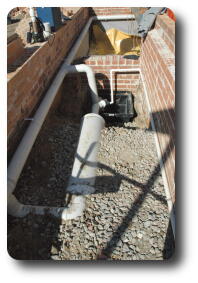
The plastic cylinder in the ground is the
first flush diverter.
This is designed to stop the initial flow from the roof entering
the bladder. The reason is that it will contain dust and leaves,
stuff best kept out of the bladder.
The operating principle is quite simple. The roof water enters from
the top right and flows to the lowest point, the T piece on the very
far left. This feeds to the cylinder, which is just a storage
device. At the far end, over the sump, is a small orifice. As the
intial rain water comes in, it flows into the cylinder, filling it
up (presuming the inflow rate is greater than the flow out).
Once the tube fills, the water then starts flowing into the bladder
via the second T piece, about mid image.
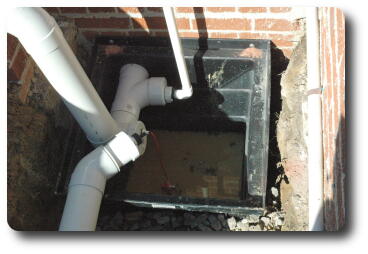
A close up of the drainage sump (pit). Apart from collecting ground
water, it also receives the slow outflow from the first flow diverter,
shown here on the lower left. (From time to time, the diverter
needs to be cleaned out of the debris which accumulates.)
The pipe at the top left is the feed into the bladder (when the
diverter has filled), and the small pipe on the right is the feed
to the pump for distribution. The feed-in pipe also has a
water level sensor to stop the pump if the water level is too low.
There will be a pump to remove water from the sump, regardless
of the source - surface water or diverter output. It empties
into the storm water drains.
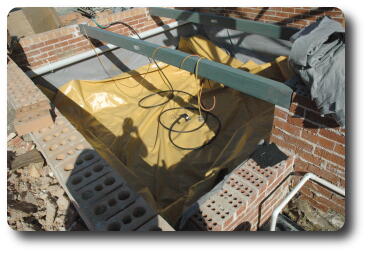 The bladder installed. The black hose on the top is a breather pipe,
to allow air to escape as the bladder fills. Though at the moment
I can't see why it is needed!
The bladder installed. The black hose on the top is a breather pipe,
to allow air to escape as the bladder fills. Though at the moment
I can't see why it is needed!
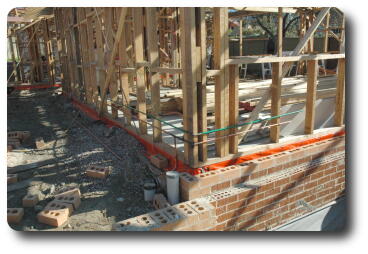 And Dave has been running pipes around too - these are the hot and cold
pipes running to the kitchen (on the right), and back to the rest of the
house (left). It appears that the water feed to the house comes in
here (the pipe running down) and there will also be a town water tap,
although its hard to see in the photo.
And Dave has been running pipes around too - these are the hot and cold
pipes running to the kitchen (on the right), and back to the rest of the
house (left). It appears that the water feed to the house comes in
here (the pipe running down) and there will also be a town water tap,
although its hard to see in the photo.
 The western end of the porch area, showing the pump,
filter and the automatic switch over to town water if the bladder
is emptied. The rain water in the bladder is used to fill the
toilet cisterns, and outside taps. Thus, it is important that
there be a backup water supply should the bladder be emptied.
The western end of the porch area, showing the pump,
filter and the automatic switch over to town water if the bladder
is emptied. The rain water in the bladder is used to fill the
toilet cisterns, and outside taps. Thus, it is important that
there be a backup water supply should the bladder be emptied.





